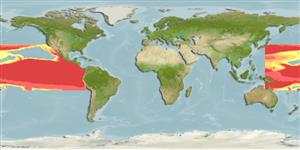Environment: milieu / climate zone / depth range / distribution range
Écologie
marin; profondeur 1 - 20 m (Ref. 89972). Tropical; 37°N - 18°S, 138°E - 77°W
Eastern Pacific: from Galapagos to Hawaii and across the Pacific to SE Japan, Guam and Palau, and Marquesas; possibly Micronesia.
Taille / Poids / Âge
Maturity: Lm ? range ? - ? cm
Max length : 59.0 cm TL mâle / non sexé; (Ref. 38398); common length : 25.0 cm TL mâle / non sexé; (Ref. 55763); poids max. publié: 2.0 kg (Ref. 38398)
Épines dorsales (Total) : 11; Rayons mous dorsaux (Total) : 15; Épines anales: 3; Rayons mous anaux: 14; Vertèbres: 26. This species is distinguished by the following characters: body oval elongate, somewhat compressed; body distinctively coloured with wavy yellow and bluish stripes horizontal to the body, originating from mouth with a yellow and a blue wavy stripe stretching back to the caudal peduncle; head yellow to silvery with blue streak behind eye on operculum; metallic blue dorsally and white ventrally; caudal fin deeply forked; very low dorsal and anal fins; D XI,15; A III,14; teeth incisor-shaped: scales on interorbital region; external side of first gill arch with high number of gill rakers, 16-19 on lower limb, 7-8 on upper; total lateral line scale rows 80-85, 59-64 with pores; longitudinal scale rows 68-77; precaudal vertebrae 10, caudal 16; pterygiophores, anal 15 and dorsal 24 (Ref. 95491).
Occurs both as solitary individuals and in schools together with K. elegans and K. vaigiensis and are found close to the surface (< 25 m) on rocky shores, the open ocean and reefs on isolated islands (Ref. 95491). Also swim rapidly in small, somewhat polarized groups or schools in open water over deep reefs, along walls and drop-offs (Ref. 5227) or usually seen near floating logs far out to sea (Ref. 11482). This species differs from its congeners in having an omnivorous diet that includes zooplankton (Ref. 95491). Not common.
Life cycle and mating behavior
Maturité | Reproduction | Frai | Œufs | Fécondité | Larves
Knudsen, S.W. and K.D. Clements, 2013. Revision of the fish family Kyphosidae (Teleostei: Perciformes). Zootaxa 3751(1):001-101. (Ref. 95491)
Statut dans la liste rouge de l'IUCN (Ref. 130435: Version 2024-1)
Menace pour l'homme
Harmless
Utilisations par l'homme
Pêcheries: intérêt commercial mineur
Outils
Articles particuliers
Télécharger en XML
Sources Internet
Estimates based on models
Preferred temperature (Ref.
123201): 21 - 29.3, mean 27.1 °C (based on 17166 cells).
Phylogenetic diversity index (Ref.
82804): PD
50 = 0.5000 [Uniqueness, from 0.5 = low to 2.0 = high].
Bayesian length-weight: a=0.01778 (0.00765 - 0.04135), b=3.01 (2.81 - 3.21), in cm total length, based on LWR estimates for this (Sub)family-body shape (Ref.
93245).
Niveau trophique (Ref.
69278): 3.5 ±0.37 se; based on food items.
Résilience (Ref.
120179): Milieu, temps minimum de doublement de population : 1,4 à 4,4 années (Preliminary K or Fecundity.).
Fishing Vulnerability (Ref.
59153): Moderate vulnerability (44 of 100).
Nutrients (Ref.
124155): Calcium = 101 [48, 199] mg/100g; Iron = 1.06 [0.62, 1.86] mg/100g; Protein = 18.4 [17.2, 19.4] %; Omega3 = 0.159 [0.087, 0.281] g/100g; Selenium = 37.2 [18.4, 82.1] μg/100g; VitaminA = 14.4 [4.1, 49.7] μg/100g; Zinc = 1.05 [0.72, 1.61] mg/100g (wet weight);
